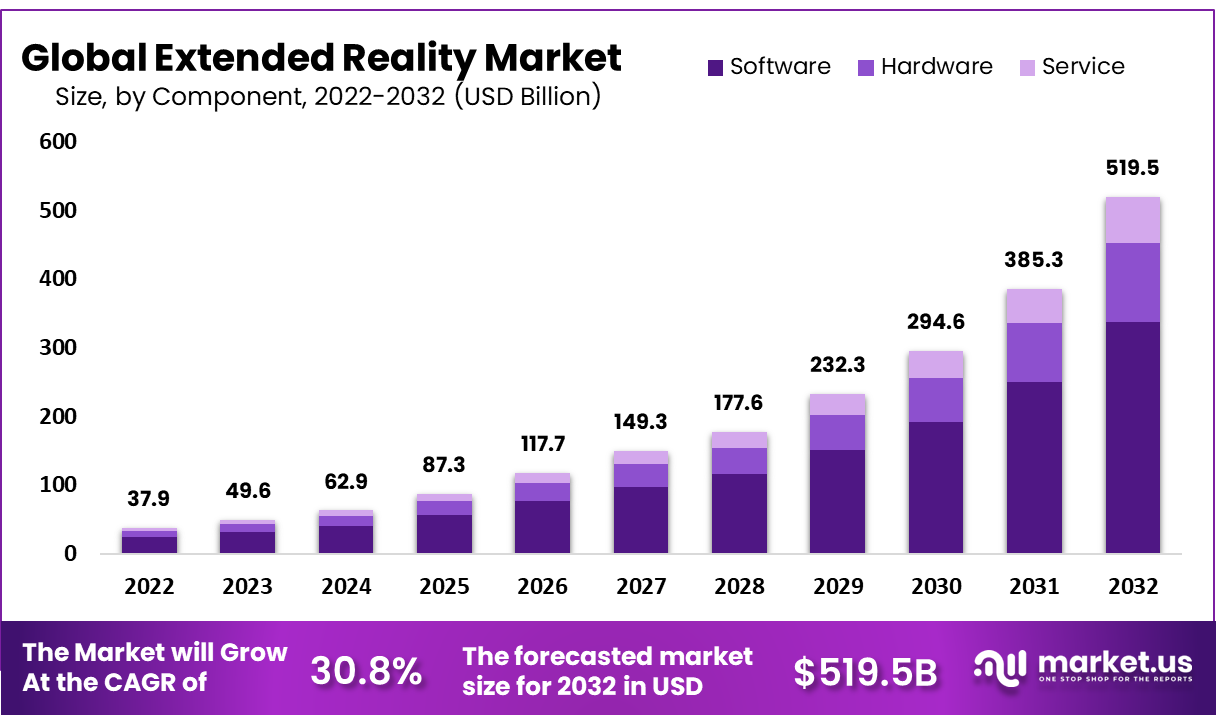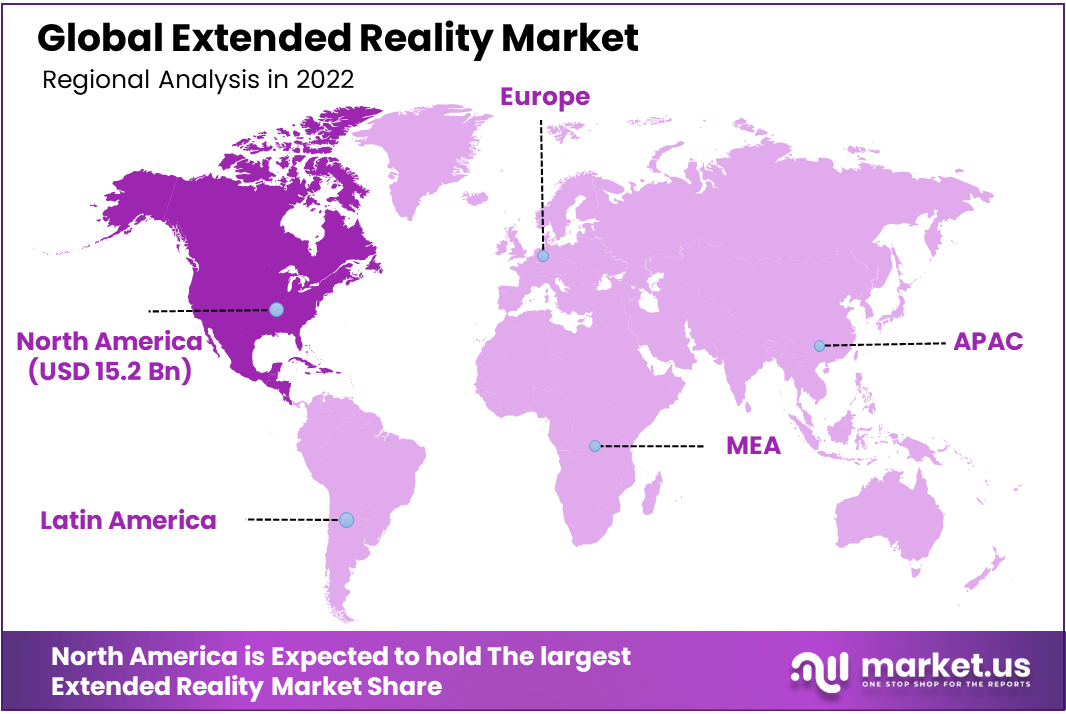New York, Feb. 13, 2024 (GLOBE NEWSWIRE) -- According to Market.us, The Extended Reality Market is likely to jump from USD 49.6 Billion in 2023 to USD 519.5 Billion by 2032. This projected expansion is anticipated to result from an average 30.8% CAGR in the demand for the extended reality market over the upcoming decade.
XR is a transformative technology that merges the physical and virtual worlds to create immersive environments for users, whether by overlaying digital information onto the physical world (AR), immersing users in a completely virtual environment (VR), or blending both physical and digital elements (MR). This technology has applications across a broad spectrum of industries, including entertainment, education, healthcare, retail, and manufacturing, providing innovative solutions for immersive learning, training, remote work, and customer experiences.
The Extended Reality (XR) market is experiencing rapid growth, driven by advancements in hardware and software that make these technologies more accessible and effective. The proliferation of smartphones and wearable technology with AR capabilities, along with more affordable VR headsets, has democratized access to XR experiences. Furthermore, the demand for remote collaboration tools, particularly highlighted by the global shift towards remote work and digital interaction due to the COVID-19 pandemic, has accelerated the adoption of XR solutions in both the consumer and enterprise sectors.
Request Sample Report and Drive Impactful Decisions: https://market.us/report/extended-reality-market/request-sample/

Key Takeaways in Extended Reality (XR) Market:
- The extended reality market is projected to experience staggering growth, with an expected compound annual growth rate (CAGR) of 30.8% between 2023-2032, reaching a remarkable USD 519.5 billion by 2032.
- Components: The software segment holds the largest share, accounting for 65% of the market.
- Technology: AR (Augmented Reality) holds the dominant position, with a market share of 55%.
- End-User: The gaming sector stands as the most lucrative, capturing the largest revenue share of 45%.
- North America leads the extended reality market, capturing the largest share of 40% in 2022 and anticipated to register a CAGR of 32.2% during the forecast period. Factors such as the increasing use of smartphones, deployment of 5G, and rising demand for extended technology across diverse applications propel the region's growth.
Build a Future-proof Business! Buy our Premium Insights at Affordable Prices Now: https://market.us/purchase-report/?report_id=102359
Factors Affecting the Growth of the Extended Reality (XR) Market
- Technological Advancements: Continuous advancements in XR hardware, software, and underlying technologies play a pivotal role in driving market growth. Breakthroughs in display technologies, sensor integration, haptic feedback, and spatial computing capabilities enhance the immersive experiences offered by XR solutions, fueling demand and adoption.
- Consumer Demand and Experience Expectations: Evolving consumer preferences and expectations for immersive digital experiences drive demand for XR applications across gaming, entertainment, retail, and marketing sectors. As consumers seek more engaging, interactive, and personalized experiences, XR technologies emerge as powerful tools to meet these demands and differentiate brands in competitive markets.
- Industry Vertical Adoption: The adoption of XR technologies varies across different industry verticals, with sectors such as healthcare, education, manufacturing, and automotive witnessing significant growth. XR applications in training, simulation, remote collaboration, product visualization, and customer engagement drive adoption in these sectors, fueled by the need for efficiency, innovation, and competitive advantage.
- Regulatory Environment and Standards: Regulatory frameworks, industry standards, and ethical considerations shape the development, deployment, and use of XR technologies. Clear guidelines and standards ensure interoperability, safety, privacy, and ethical use of XR solutions, fostering trust among users, businesses, and regulators and accelerating market growth.
- Investment and Funding: The availability of investment and funding from venture capital, private equity, government grants, and corporate partnerships accelerates XR technology development, research, and commercialization efforts. Increased investment drives innovation, expands market reach, and supports ecosystem growth, catalyzing market expansion and competitiveness.
Explore Our Methodology to Understand our Research Process: https://market.us/report/extended-reality-market/request-sample/
Report Segmentation
By Component Analysis
In the evolving landscape of the global extended reality (XR) market, the software segment emerges as the most lucrative, boasting a projected Compound Annual Growth Rate (CAGR) of 31%. This impressive growth rate underscores the critical role software plays in the XR ecosystem, facilitating the creation, management, and deployment of immersive content and applications. In 2022, the software component commanded a significant total revenue share of 65%, highlighting its dominance and the high demand for innovative XR applications across various industries.
The software segment's growth is driven by the increasing need for sophisticated development platforms, content creation tools, and application interfaces that can cater to the expanding scope of XR technologies. As XR experiences become more complex and widespread, the software that powers these experiences continues to evolve, offering enhanced functionalities, improved user interfaces, and seamless integration with existing technologies, thereby fueling the segment's growth and market share.
By Technology Analysis
Augmented Reality (AR) technology stands out as the most lucrative segment within the extended reality market, capturing a dominant market share of 55% and boasting a projected Compound Annual Growth Rate (CAGR) of 29.9% in 2022. This prominence reflects AR's versatility and its ability to blend digital information with the physical environment, offering transformative experiences across consumer, enterprise, and industrial applications.
AR's appeal lies in its accessibility through smartphones and wearable devices, making it a pivotal technology for a wide array of applications, from retail and marketing to education and healthcare. The technology's ability to provide enhanced, interactive user experiences without the need for complete immersion in a virtual environment positions AR as a key driver of the XR market's growth. As AR technology continues to advance, with improvements in visual fidelity, user interaction, and device compatibility, its market share and impact are expected to expand further, solidifying its status as a cornerstone of the XR industry.
By End-User Analysis
Within the global extended reality (XR) market, the gaming segment is estimated to be the most lucrative, holding the largest revenue share of 45% and projecting a Compound Annual Growth Rate (CAGR) of 33.4% during the forecast period. This segment's dominance is attributable to the immersive and engaging experiences that XR technologies offer to gamers, revolutionizing the way games are played and experienced. XR gaming not only enhances the visual and interactive aspects of gaming but also introduces new gameplay mechanics and narratives that were previously unattainable.
The continuous innovation in XR hardware, such as headsets and motion capture devices, coupled with the development of new gaming titles designed specifically for XR platforms, fuels the growth of this segment. As XR technology becomes more mainstream and accessible, the gaming industry is poised to remain at the forefront of adopting and integrating these advancements, driving significant market share and growth within the XR ecosystem.
Purchase the Competition Analysis Dashboard Today: https://market.us/purchase-report/?report_id=102359
Top Market Leaders
- Qualcomm Technologies Inc.
- Accenture PLC
- SoftServe Inc.
- SphereGen Technologies LLC
- Northern Digital Inc.
- Microsoft Corporation
- Softweb Solutions Inc. (Avnet Inc.)
- Tata Elxsi Limited
- Varjo Technologies Oy
- Talespin Reality Labs Inc
- Other Key Players
Recent Development
SphereGen Technologies LLC:
- March 2023: Announced a new AR development kit with improved hand tracking and spatial mapping capabilities.
- December 2023: Secured $20 million in funding to expand its R&D efforts in AR for industrial applications.
Scope of the Report
| Report Attributes | Details |
| Market Value (2023) | USD 49.6 Billion |
| Forecast Revenue 2033 | USD 519.5 billion |
| CAGR (2023 to 2032) | 30.8% |
| North America Revenue Share | 40% |
| Base Year | 2023 |
| Historic Period | 2018 to 2022 |
| Forecast Year | 2023 to 2032 |
Regional Analysis
North America is poised to assert its dominance in the global extended reality (XR) market, commanding the largest market share of 40% and projecting a robust Compound Annual Growth Rate (CAGR) of 32.2% during the forecast period. This region's prominence can be attributed to several key factors that position it as a powerhouse in the XR landscape.
Firstly, North America boasts a thriving ecosystem of technology companies, research institutions, and startups that are driving innovation and pushing the boundaries of XR technology. Silicon Valley, in particular, serves as a hub for XR development, attracting talent and investment from around the world.
Secondly, the region benefits from strong consumer demand for immersive experiences across various sectors, including gaming, entertainment, healthcare, education, and enterprise. The widespread availability of XR devices and content, coupled with high levels of disposable income, fuels market growth and adoption.
Furthermore, North America's supportive regulatory environment and robust infrastructure, including advanced telecommunications networks and cloud computing capabilities, facilitate the development and deployment of XR solutions. This infrastructure enables seamless connectivity and data processing, enhancing the user experience and enabling real-time interactions in virtual environments.

Key Market Segments
Based on Component
- Hardware
- Software
- Service
Based on Technology
- AR
- VR
- MR
Based on End-User
- Gaming
- Retail
- Healthcare
- Manufacturing
- Media and Entertainment
- Education
- Aerospace and Defense
- Other End-Users
By Geography
- North America
- The US
- Canada
- Europe
- Germany
- France
- The UK
- Spain
- Italy
- Russia
- Netherland
- Rest of Europe
- APAC
- China
- Japan
- South Korea
- India
- Australia
- New Zealand
- Singapore
- Thailand
- Vietnam
- Rest of APAC
- Latin America
- Brazil
- Mexico
- Rest of Latin America
- Middle East & Africa
- South Africa
- Saudi Arabia
- UAE
- Rest of MEA
Explore Extensive Ongoing Coverage on Technology Research Reports Domain:
- Fraud Detection and Prevention (FDP) Market valuation is set to reach USD 2226.0 billion by 2033, projected to increase at 20% CAGR.
- Big data as a Service Market is anticipated to be USD 809.7 billion by 2033. It is estimated to record a steady CAGR of 33.1%.
- Augmented reality and Virtual reality market size is expected to be worth around USD 106.2 Billion by 2033, growing at a CAGR of 11.8%
- Supercapacitors Market is likely to jump from USD 5.0 Bn in 2024 to USD 21.7 Bn by 2033, expand at a rate of 17.7% CAGR.
- E-Commerce Personalization Software Market is expected to garner a 24.8% CAGR and reach a size of USD 2,412 Million by 2033.
- Generative AI in Content Creation Market is anticipated to be USD 175.3 billion by 2033. It is estimated to record a steady CAGR of 31.2%
- Biometric Technology Market is projected to be valued at USD 198.5 billion in 2033, expand at a 15.4% CAGR during the forecast period.
- Affective computing market is anticipated to reach a high of USD 1,130.8 Bn by the year 2033, steady CAGR of 32.5% in the forecast period.
- EdTech Market size is expected to be worth around USD 549.6 Billion by 2033, from USD 146.0 Billion in 2023, growing at a CAGR of 14.2%.
About Us
Market.US (Powered by Prudour Pvt Ltd) specializes in in-depth market research and analysis and has been proving its mettle as a consulting and customized market research company, apart from being a much sought-after syndicated market research report-providing firm. Market.US provides customization to suit any specific or unique requirement and tailor-makes reports as per request. We go beyond boundaries to take analytics, analysis, study, and outlook to newer heights and broader horizons.
Follow Us On LinkedIn Facebook Twitter
Our Blog:
